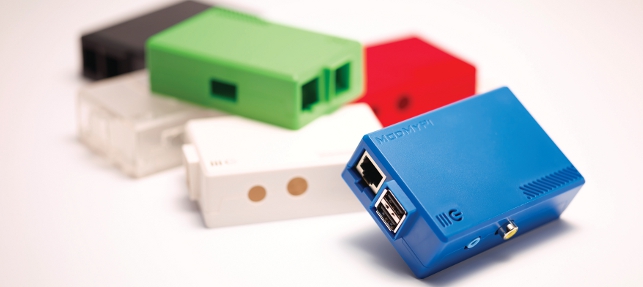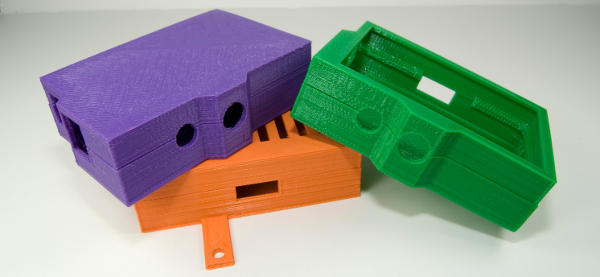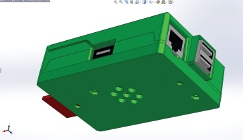Before February last year if someone had said ‘Raspberry Pi’ to you, you probably would have imagined something edible, fruit based and covered in pastry.

ModMyPi Raspberry Pi cases are injection moulded from strong ABS plastic
But one year on most people, especially kids, know that a Raspberry Pi is a £22 (or $35) low-powered Linux computer that weighs just 45g and is the size of a deck of cards.
The Raspberry Pi Foundation grew out of the University of Cambridge’s Computer Laboratory whose professors and lecturers became increasingly concerned by the decline in the skills of A Level students applying to study computer science.
Their aim was to create a cheap programmable computer that could help promote the study of computer science and programming at school level.
As it states on the Raspberry Pi Foundation’s website: “We want to break the paradigm where without spending hundreds of pounds on a PC, families can’t use the internet. We want owning a truly personal computer to be normal for children.”
Following six years of development by the registered charity, the Raspberry Pi model B was ready for launch in February 2012. It consisted of 512MB RAM, two USB ports to connect to peripherals such as a mouse, TV and keyboard as well as an Ethernet port for connection to the internet.
Manufactured in Taiwan and China with parts from Samsung, Sony and Broadcom, there are two official distributors of the Raspberry Pi – RS Components and Premier Farnell.
The day it went on sale, the first batch of 10,000 sold out within minutes. In the past year, the Raspberry Pi Foundation estimates that over one million units have been sold worldwide.
Covering it up
The device comes as just a bare circuit board vulnerable to all sorts of hazards such as knocks, dust and drink spills.
As a result it sparked many designers and makers to design cases, which they’ve either uploaded and shared on sites like Shapeways and Thingiverse for others to buy or print on a 3D printer (see box out below) or they’re manufacturing the cases themselves.
For example, Jacob Marsh who founded ModMyPi in February 2012, shortly after Raspberry Pi’s launch.
It was whilst studying a Masters in Civil Engineering at Exeter University that Marsh first heard about the development of this mini computer.
Him and his friends became increasingly interested in it. “I think one of the main reasons why it’s so appealing is that it’s something you can really play around with,” comments Marsh.
“As a kid I would watch my dad fiddle around with his car and take stuff apart and then put it back together again. But with many devices today, your phone for example, you have no idea how it works, you just use it. But with the Raspberry Pi, it’s all open source, so you can take it apart on a programming level, and see the innards working.”
On the case
Whilst still at University, Marsh set about designing a case for the device.
He modelled it in SolidWorks using the workstations in the engineering department. “My aim was to obviously make it functional but I wanted it to look good too. I’m a fan of minimalist forms with smooth curves and wanted to create something that would look smart sitting on a desk,” he describes.
With the Centre for Additive Layer Manufacturing (CALM) located within the College of Engineering, Mathematics and Physical Sciences, Marsh used its facilities to prototype his case.
“This was all subsidised by the South West Manufacturing Advisory Service (SWMAS) as there are grants available for new businesses such as mine,” adds Marsh.
With the design finalised, Marsh’s intention was to use 3D printing to manufacture the cases in low volumes. “This original plan went out the window when we put the cases up for sale online – I think we got 400 orders in the first day. With 3D printing you can probably make 20 or 30 a day which meant we had a month’s worth of manufacturing in a day’s worth of orders,” he explains.
Change of plan
So Marsh had to find an alternative production method, and fast.
The SWMAS put him in touch with Hymid, a mould tool manufacturer based in nearby Torquay, Devon.
“I met up with Hymid and they gave me a really good quote for the original tooling,” says Marsh. “They were also really helpful with the design because when you go from 3D printing to injection moulding there are a lot of slight differences that need to be made to the design in terms of adding draft angles and such.”
The cases were injection moulded from strong ABS plastic in five different colours with each one sold for £5.99. Marsh explains that he wanted to keep it low cost as that’s the whole intention of the Raspberry Pi itself. And although ModMyPi is not affiliated with the Raspberry Pi Foundation, it still supports what the charity is striving to achieve and so donates five per cent of all profits to the Foundation.
In just one year, as the sales of the Raspberry Pi have exploded so has Marsh’s small business grown. He has already sold over 40,000 units and now employs a team of people to help package them to send out. As well as becoming a Raspberry Pi reseller, selling the computer and case in one package, he also sells a range of peripherals and accessories in the online shop.
Additionally, he has increased the range of cases to include new colours as well as providing the ability for customers to customise their cases themselves.
For young and old
Children are using the Raspberry Pi at home with their parents but there are also a number of self-motivated teachers who have undertaken training courses to enable them to teach computer programming using the device at school.
They are also devising school projects and materials around it.
For instance, Dr Andrew Robinson at the University of Manchester’s School of Computer Science has recently teamed up with STEMnet (Science, Technology, Engineering and Mathematics Network) ambassadors to run workshops in a variety of schools.
Additionally, a team of UK teachers from Computing at School (CAS), in conjunction with the Raspberry Pi Foundation, have developed an educational user manual for the Raspberry Pi, which is free to download.
But it’s not just children and the educational community who are interested in this mini computer; adults from all sectors have found interesting applications and uses for it.
For instance, Cambridge engineering student Jordan Burgess managed to convert his Raspberry Pi into an AirPlay receiver similar to Apple’s AirPort Express, using open source software, a USB Wi-Fi adapter, an SD card, a micro USB cable and the Raspberry Pi itself. With this hack the computer imitates an airplay speaker, making it possible to send songs wirelessly to his stereo.
The Raspberry Pi Foundation enjoys seeing projects like this and how the open source community is hacking its cheap, accessible and programmable computer. It’s what it was designed for.
The charity also actively encourages companies to clone what it’s doing. Exciting times.
Print your own
The worldwide 3D printing community on Shapeways.com and Thingiverse.com have designed a range of cases for the Raspberry Pi that can be purchased or licensed. Here are a few:

theKranko v1.0
Creator: theKranko, Ranko Davidovic, Sweden
Description: “The case was designed in SolidWorks 2012. I started out by downloading a 3D CAD model of a Raspberry Pi and then building a ‘basic case’ around it.
With all the major dimensions done, I proceeded to add some basic features to it, like the wavy legs and the pi with 13 decimals.
I figured since many cases had the Greek letter pi on them or a pie, I wanted to be different so I used the mathematical aspect of it.”
Cost: From $43.99
shpws.me/lv98
Raspberry Pi: Design Case V2
Creator: FreakyShape, Loic Blascos, France
Description: “I’m an engineer in the material sciences field and I’m always using SolidWorks.
So I used it to design my original V1 case, which is a cheap case but it maintains good mechanical properties and has a good visual aspect.
I was one of the first to draw a case for the Raspberry Pi and I wanted to give it a modern look and not make it just a square box. V2 is the same as V1 but I tried to bring the cost down. It also provides access to a GPIO connector.”
Cost: From $32.07
shpws.me/lmkx
Raspberry Pi CASE 1.0
Creator: MarcoA, Marco Alici, Italy
Description: “My Raspberry Pi case, which has all the features you need, was designed in Autodesk Inventor with photorealistic rendering done in Blender, a 3D modelling and rendering program, as well as Yafaray (formerly YafRay), a realistic rendering engine for Blender.”
Cost: From $38.60
shpws.me/llYs

Raspberry Pi Case 2 (RasPi)
Creator: redpepper, Sarah Prelutsky, USA
Description: “Here in the San Francisco Bay area we have a place called Tech Shop that taught me how to use Autodesk Inventor right around the time I got my Raspberry Pi.
So naturally the best way to further my learning was to fix my original Raspberry Pi model! I went to a few more classes and was able to ask the teacher how to improve the design and make it easier to make adjustments to where holes are on the case.”
Cost: Creative Commons license to download and 3D print
thingiverse.com/thing:30572
Raspberry Pi and a case for 3D printing
Default







